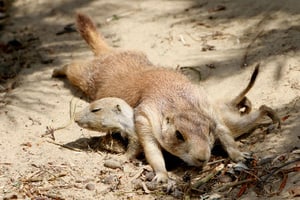A list of my favorite images of prairie dogs.
en.wikipedia.org/wiki/Prairie_dog
Prairie dogs (genus Cynomys) are herbivorous burrowing rodents native to the grasslands of North America. They are a type of ground squirrel found in the United States, Canada and Mexico.
The five species are: black-tailed, white-tailed, Gunnison's, Utah and Mexican prairie dogs. Despite the name, they are not canines.
In Mexico, prairie dogs are found primarily in the northern states, which lie at the southern end of the Great Plains: northeastern Sonora, north and northeastern Chihuahua, northern Coahuila, northern Nuevo León and northern Tamaulipas.
In the United States, they range primarily to the west of the Mississippi River, though they have also been introduced in a few eastern locales.
On average, these stout-bodied rodents will grow to be between 30 and 40 cm (12 and 16 in) long, including the short tail, and weigh between 0.5 and 1.5 kilograms (1 and 3 lb).
Prairie dogs are chiefly herbivorous, though they eat some insects. They feed primarily on grasses and small seeds.
In the fall, they eat broadleaf forbs. In the winter, lactating and pregnant females supplement their diets with snow for extra water. They also will eat roots, seeds, fruit and buds. Grasses of various species are eaten.
Black-tailed prairie dogs in South Dakota eat western bluegrass, blue grama, buffalo grass, six weeks fescue and tumblegrass, while Gunnison’s prairie dogs eat rabbit brush, tumbleweeds, dandelions, saltbush and cacti in addition to buffalo grass and blue grama. White-tailed prairie dogs have been observed to kill ground squirrels, a competing herbivore.
Prairie dog burrows are 5–10 m (16–33 ft) long and 2–3 m (6.6–9.8 ft) below the ground. The entrance holes are generally 10–30 cm (3.9–11.8 in) in diameter.
Prairie dog burrows can have up to six entrances. Sometimes the entrances are simply flat holes in the ground, while at other times they are surrounded by mounds of soil either left as piles or hard packed.
Some mounds, known as dome craters, can be as high as 20–30 cm (7.9–11.8 in) high. Other mounds, known as rim craters, can be as high as 1 m.
Dome craters and rim craters serve as observation posts used by the animals to watch for predators. They also protect the burrows from flooding. The holes also possibly provide ventilation as the air enters through the dome crater and leaves through the rim crater, causing a breeze though the burrow.
Prairie dog burrows contain chambers to provide certain functions. They have nursery chambers for their young, chambers for night, and chambers for the winter. They also contain air chambers that may function to protect the burrow from flooding and a listening post for predators. When hiding from predators, prairie dogs use less-deep chambers that are usually a meter below the surface. Nursery chambers tend to be deeper, being two to three meters below the surface.
Highly social, prairie dogs live in large colonies or "towns", and collections of prairie dog families that can span hundreds of acres. A prairie dog town may contain 15–26 family groups. There may also be subgroups within a town, called "wards", which are separated by a physical barrier. Family groups exist within these wards.
The prairie dog family groups are the most basic units of its society. Members of a family group inhabit the same territory. Family groups of black-tailed and Mexican prairie dogs are called "coteries", while "clans" are used to describe family groups of white-tailed, Gunnison’s and Utah prairie dogs. Although these two family groups are similar, coteries tend to be more closely knit than clans.
Members of a family group interact through oral contact or "kissing" and grooming one another. They do not perform these behaviors with prairie dogs from other family groups.
 Login
Login










































